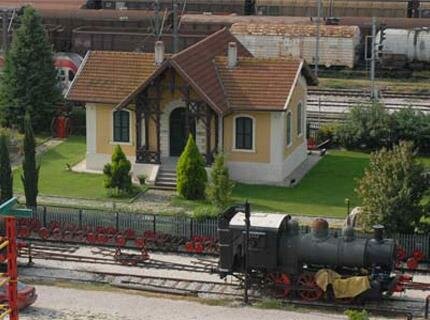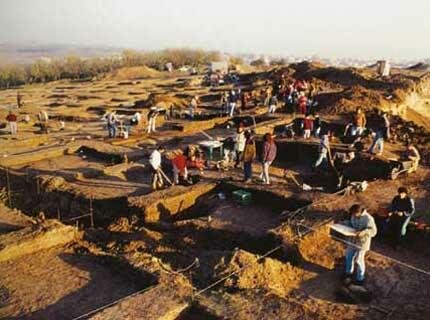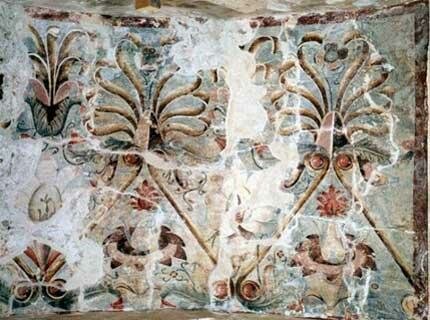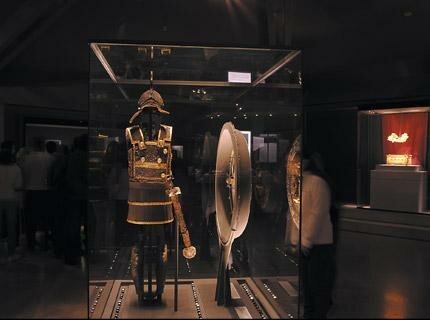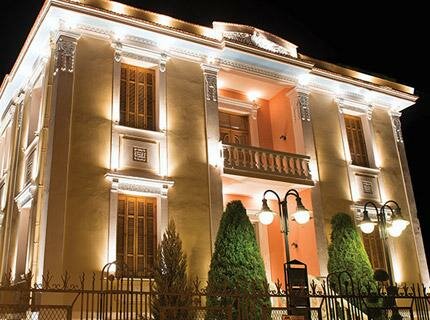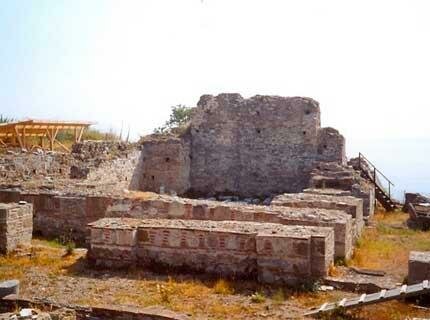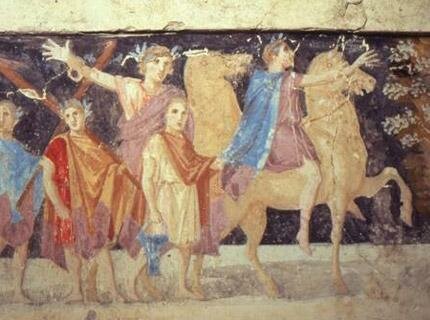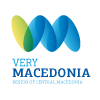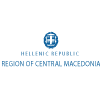Culture
1977 年,Manolis Andronikos 教授与其同事在中马其顿大区伊马夏州 Vergina village(维尔吉纳村)发掘了一座巨大的古墓,成为 20 世纪希腊最重要的考古发现。现维尔吉纳(Ancient Aigai——古埃格)坐落在 Pieria(皮埃里亚)山脚下,曾是古马其顿王国的第一个都城 Ancient Aigai(古埃格)的所在地。在皇家陵墓的发掘点建起了一座现代风格的顶盖,顶盖下方为墓穴的主入口,并且陈列了在墓葬中发现的主要文物。联合国教科文组织已将此处评定为世界文化遗产,这里独特的考古发现对世界文明进程的研究有着广泛巨大的影响。
从公元前 3000 年起,这一区域就持续有人居住,这里还有一直延续到罗马时代的 Aigai(埃格)古城的废墟,计有一处卫城、一处宫殿、一处剧场,大量的神殿和住宅建筑,以及一片包括数以百计墓穴的广阔墓地。
文物陈列的上盖是大古墓的外部结构,一座人工建起的土墩,古墓的地下建筑则从 1997 年 11 月至今陈列着在其中发现的墓穴和珍宝。土墩结构之下包括了三座马其顿王国的皇家墓穴:腓力二世的完整墓穴(II 号墓),墓穴带有一幅描绘狩猎场景的湿壁画。还有一座被称为王子之墓的墓穴(III 号墓)亦保存完整,可能属于腓力二世的孙子亚历山大四世以及他的儿子亚历山大大帝,另外一座是建于公元前三世纪的皇家墓穴(IV 号墓),已被盗墓者破坏,如今仅存废墟。
参观者还可看到一座被称为“Persephone 之墓” 的家族墓穴(I 号墓),其石棺已经被盗,其湿壁画描绘了冥王 Hades 劫持 Persephone 的场景,临近石棺还有一座已剩废墟的 Heroon 英雄祠,可能是用来祭祀毗邻埋藏的皇室成员。展品中有两件为金制的瓮罐,存有腓力二世和他一位妻子的骸骨,还有皇室死者佩戴的金色花环,其中两件为橡木,一件为长春花。展品中还有一件十分罕见的金色与紫色刺绣的布块,包裹着皇室妻子的骸骨,随葬的还有妻子的金质王冠,工艺独特,另有两张象希腊人娱乐与进行研讨时使用的躺椅,还有腓力二世的武器和铠甲,皇室家族娱乐与研讨时使用的珍贵器物,以及“王子”的银制瓮罐。
http://www.imathia.gr:80/tourism/archaeological/vergina.htm
http://www.visitgreece.gr/en/culture/archaeological_sites/vergina
http://www.aigai.gr/
Administrative Information
Official Unit:
9th Ephorate of Byzantine Antiquities
Τ.Κ. 60065, Platamonas (Prefecture of Pieria)
Telephone: +30 23520 42775
Fax: +30 23520 44470
Email:
Open
Everyday: 08:00-15:00
http://odysseus.culture.gr/h/3/eh355.jsp?obj_id=7961
在马其顿当代艺术博物馆,您将一睹塞萨洛尼基充满活力的当代文化,其中包括各种形式的当地和国际艺术收藏,如摄影、绘画、雕刻、综合媒介以及视频装置等。
www.mmca.org.gr/
塞萨洛尼基至君士坦丁堡铁路线军用车站位于塞萨洛尼基城西。
与 Monastiriou 路立交桥入城出口相隔约 500 米,铁路主线建有新站,经过 Kordelio – Evosmos 市的行政边界。
建筑时间为 19 世纪后期( 1891 年至 1894 年),当时的塞萨洛尼基是奥斯曼帝国的一部分。火车站由意大利建筑师 Pierro Arigoni 设计,他还在 1911 年设计了 Casa Bianca 的建筑。
http://www.sfsth.gr/
The Museum is largely the result of forty years of untiring efforts by Stavros Kovrakis, a passionate collector of the treasures hidden in the seas of Greece. It also enjoys the support of the Moudania Yacht Club. The Museum has an educational and research role, also doing much to promote the local identity and keep alive its links with its history. The items on display include ancient anchors, fishing nets, fishing rods and hooks, compasses, beacons and lamps and many other intriguing exhibits. There are 3D recreations of a variety of fishing techniques, demonstrating how the different kinds of vessel and net are used, with replicas of fishing boats and a rich archive of documents and illustrations. One of the most fascinating items is the bouyiandes, a traditional fishing vessel formerly seen in the Sea of Marmara, introduced to Greece by the refugees from Asia Minor. The Museum also offers a thrilling insight into the strange and magical world beneath the sea, with its vast range of plant and animal life.
(More Info: H +30 23730 26166)
On the ground floor of the Aretra building in the central square of Athytos there is a display of folk exhibits created on the initiative of the painter Nikos Paralis. The items represent the whole cycle of rural life in the region, with domestic utensils, tools, implements and so on. Open: afternoons.
The theatre was accidentally discovered in 1992, on a natural slope and it probably belonged to the ancient Macedonian city of Mieza. The cavea has fifteen rows of seats carved in the rock. The scene complex comprises the built proskenion which has a facade with doric semi-columns and the skene which is unfortunately preserved in a poor conndition. Its capacity is estimated at 1,500 people. The theatre was constructed in the late Hellenistic period.
After its accidental discovery, in 1992, the excavation of the monument began and is still conducted by the archaeologists V. Michailidou and V. Allamani.
http://kopanos-imathias.blogspot.com/
展品按照编年顺序,分为三个展厅:展厅 A (前厅)展示史前时期的文物。其中最重要的展品是在 Kolchis 定居点发现的新石器时代小雕像和工具( 1 号展柜,上层和下层)。
2 号展柜展示了一小部分铁器时代早期的铜制珠宝馆藏,是在基尔基斯地区多个地点发现的。其中大部分为手镯,嵌以众多螺旋状和环装饰件以及垂饰,后者的种类、形状十分丰富,比如船锚、罐子、鸟、瓶子(上层和下层)。
受限于博物馆的空间,同一展厅的展品还包括一件墓碑,描绘了一名骑士被释放的场景,以及一座 Attic(阿提卡)石棺的局部,描绘了一群年轻人和一匹战马,以及 Morrylos ( Ano Apostoloi )市的一次特赦。
B 展厅展出了发掘自 Old Gynaikokastro 铁器时代墓穴的物品,包括特色鲜明的瓮具和祭品、武器、刀具、双刃斧以及首饰。在同一展厅的拐角处展示古代葬礼的复制场面。
C 展厅展示了不同历史时期的文物,主要包括雕塑、瓶子、首饰以及日常生活用品。其中最引人注目的展品有: Europos 青年雕像,时间可追溯至公元前 6 世纪; 4 座在 Palatiano 的英雄祠发现的雕像,可追溯至公元 2 世纪;,一座狄厄尼索斯雕像,同样也是来自Palatiano,以及 Apollo(阿波罗)和 Aphrodite(阿佛洛狄特)的雕像各一座,分别来自 Mikro Dasos 和 Chorygio 。
6 号展柜和 7 号展柜展出了个人捐赠的文物以及早先发掘的文物。6 号展柜中央展出了一件保存完好的古典头盔,头盔的正面雕有面对狮子的场景,其他展品包括发掘自不同地点的瓶子和小型雕像。
7 号展柜(上层)的展品都是在 Philyria 发掘的祭祀品,其中有描绘鹰头狮吞食雄鹿场面的粘土镀金饰板以及其他物品。
8 号展柜展示了在 Palatiano 发掘的文物,大多为日常生活物品。其中的骨勺、雕刻图案的织机锭子以及陶俑最为引人注目。
http://www.kilkis.gr
在 Ancient Pydna(彼得那古城)的西侧和今天 Makrigialos 的西南侧坐落着希腊最大的史前定居点之一。
1992 年启动的第 16 届史前及古典研究学会发掘工作,将这一史前遗迹重现光明。
整个发掘工作覆盖面积为 60 平方公里,而整个定居区域的面积则估测在 500 平方公里左右。
发掘的文物包括住宅以及被文明驯化过的土地,手工制品,比如粘土制成的罐子,运用众多材料制作的石器,以及小型器物。同时出土的还有由粘土和大理石制成的崇拜物,以及烧焦的植物种子以及大量动物骨骸。
E. Heuzen and N.Hammond posit that this was the site of the Battle of Pydna (168 B.C.), the outcome of which being the subjugation of the Macedonians to the Roman Empire.
The ruins of a Bishop's Palace from the 5th-6th C. was found to the east of the railway line from Thessaloniki to Athens.
A square tower, 80x90 m. was found situated on the Ancient Road from Pydna to Dion. The area was built on a plan which included four fortified towers, within the confines of which a 3 chambered Basilica and a Bishop's Palace, bounded by a covered aisle have been found.
The foundations of the buildings from 479 AD are probably those of the seat of the Bishop of Pydna.
The Bishop's Palace was built on the ruins of the 2nd century baths, a mosaic floor having been found beneath its floor, and to the East of the Palace is a villa with mosaic floors dating from the time of Konstantinou and the foundations of a building which were probably those of the local tax collector's offices.
The plan with four towers remained until the time of Justinian, when its fortified character changed due to the enlargement of the warehouses and workshops for the production of wine and olive oil. It was destroyed by an earthquake in the middle of the 6th Century, after which the church was rebuilt on the central slope, the previous building area being converted into a cemetery.
The town must have been abandoned during the Bulgarian invasion at the end of the 9th Century. Today's visitor can see three of the towers, the Bishops Palace, the mosaic floors of the 4th C villa, the tombs, the springs, the ovens for baking the tiles and those in which glass was fired.
The Tomb of Lyson and Kallikles is one of the four Macedonian tombs of Lefkadia, built along the ancient road connecting the town of Mieza with Pella, the capital of the Macedonian Kingdom. The pottery discovered inside the tomb and the prosopography of the deceased indicate a date from the late third to the middle of the second centuries BC. Although the smallest tomb of the group, it is distinguished by its ornate interior. The tomb belonged to the family of Aristophanes, of which five generations were buried here. Their names are inscribed inside the rectangular niches set in two superimposed rows along the walls.
The tomb consists of a narrow ante-chamber and a rectangular burial chamber oriented north-south. The burial chamber was entered from the south through a double door. The ante-chamber has a flat ceiling and its walls have painted representations of a sprinkler and an altar. Over the door leading into the burial chamber are the names of the first two deceased, Lyson and Kallikles sons of Aristophanes. The burial chamber has twenty-two niches, of which seventeen received the ashes and grave gifts of deceased members of the family. The trompe-l'oeil Ionic antae give the impression of a true peristyle inside a garden. A continuous garland of leaves, pomegranates and ribbons crowns the peristyle, while the tympana on the short sides have paintings of weapons like those often placed as grave gifts - helmets, swords and two different types of Macedonian shields. The vividness of the colours and good state of preservation of the wall-paintings are due to the fact that the earthen tumulus covering the tomb was not removed after the monument's discovery, thus keeping the temperature and humidity inside the tomb stable. The stylistic similarities between the paintings of this tomb and the Second Pompeian Style indicate the close contacts between Hellenistic Greece and Republican Rome; this particular style (dubbed 'Architectural Style' by the archaeologist Stella Miller) may be the beginning or may have inspired the Second Pompeian Style.
The tomb was discovered by chance in 1942 and was excavated by Charalambos Makaronas who published a brief report. It was fully studied by Stella Miller. The monument is closed to the public in order to preserve the stable conditions which allowed for its remarkable preservation. A metal shelter was built over the tomb in 1999 for additional protection.
⇠ Thessaloniki 70km ⇠ Polygyros 16km
Nea Olynthos lies next to the site of ancient Olynthos (+1.5km) and is the modern counterpart of the Byzantine village of Myriofyto. It is said to have taken its present name from its founder, Olynthos, brother of the Thracian king Rissos. Others claim the name comes from the hero Olynthos, son of the river god Strymon.
Sightseeing
• Ancient Olynthos. It was located on the heights east of the present village. The area is fenced and the entrance is at the southwest foot of the heights. The location of the city has been known since the 19th century. The people in the area called it “Pirgos” after a Byzantine tower that was build there to protect the “metochi” of the Mt Athos monastery of Kastamonitou. Only the foundation of this Tower is preserved today, at the southern end of the city. For 100 years Olynthos was the most important city of Halkidiki. Its foundation goes back to mythical times. The city was destroyed in 480 B.C. by the Persians. The evidence from the excavations show that the archaic city, which was a continuation of the prehistoric one, was built on the southern hill. The north hill seems to have been the area of the new settlement of the Chalkideans. The accuracy of the city plan of Olynthos helps us understand how the Ippodamio city planning system was applied. Although the ruins are remarkable, the findings of the excavations are exhibited at the Museums of Thessaloniki and Polygyros.
• The ruins of the Byzantine church of St Nicholas, a structure of the 10th or 11th century.
• North of Olynthos, at the site known as Mariana, there is a fortified tower dating from the 14th century, built by the Docheiariou Monastery on Mt. Athos.
• About 7km from the village is the site of the ancient city of Mikyverna, the port of Olynthos, which must have been destroyed when Olynthos was laid waste by Phillip II in 348 B.C.
✓ can’t miss this!
Walk through the ancient roads of Olynthos and admire the perfection of the architecture.
More about Ancient town Olynthos
The area was constantly inhabited since the Neolithic Age. According to mythology, the town was built by the brother of Olynthos, the son of the mythic King of Thrace, Strymonas. Olynthos was killed by a lion and his brother built the town to honour his brother’s name. However, the linguists insist that olynthos is the name of the wild fig tree, which is in abundance in the area, and the town was named after it.
Around 650 BC refugees from Pieria, hunted by the Macedonian army, settled in the area. The Persian army destroyed the town in 479 BC. and offered the region to their allies from Evia (Halkida). Later on, Olynthos joined the Athenian Alliance and then the Community of Halkida (Evia). From this alliance the town gained great profits (mainly financial). So, it became the capital of the Euboan colonies in Halkidiki and was able to support a huge army (about 20.000 soldiers). During the Peloponnesian War the area grew more, had its own monetary unit and provided protection to all the Euboan refugees in Greece.
When the Macedonian State faded, the army of Olynthos conquered its territories and reached the ancient town of Pella (389 BC). In 382 BC, after a three year-long siege, the Spartans captured the town and destroyed the Euboan Community. Nevertheless, the town quickly recovered and became wealthy and powerful again. In 348 BC the Macedonian Army, under the command of Philip II, conquered it and destroyed it. The town was never again inhabited and its destruction is remembered as one of the darkest moments of the entire ancient world.
1977 年维尔吉纳(埃格)皇家陵墓一经发现,相关方面便迅速建立了一套方案,保护陵墓内的重要壁画。与此同时,在考古现场工作人员还建立了一个文物保存实验室,以便对墓穴中可以移动的极为重要的物品进行拯救和修复。为了保护皇家陵墓,1993年,工作者修建了一个地下结构,通过维持温度和湿度,同时对古代的石碑和壁画进行保护,这项措施是必不可少的。
陵墓结构的外部成土墩状;内部存放了在陵墓中发现的珍宝,1997 年 11 月开始对外展出。
电话:+30 23310 92347
电子邮件:
优惠套票:全价:8 欧元,优惠价:4 欧元
有效范围:埃格,维尔吉纳皇家陵墓保护建筑
http://www.aigai.gr/
The Museum of the Macedonian Struggle has perhaps the richest of all collections of relics and documents from the period of the Macedonian Struggle. Some of these items form part of the Museum's permanent collection, while others remain in the Research Centre for Macedonian History and Documentation (KEMIT) or in store for use after the reconfiguration of the Museum's exhibition space.
Museum for the Macedonian Struggle 23 Proxenou Koromila, GR 54622, Thessaloniki, Greece
Τ. 2310229778
Fax. 2310233108
E:
http://www.imma.edu.gr/
在塞尔迈湾西海岸,距 Makrigialos(马克里嘉洛斯)以南 1 公里,您就能看到 Kitros 主教的拜占庭城堡废墟。这些废墟、城堡的西大门(与教堂相对),还有一间客栈、若干浴室以及一座小型单室寺庙的地基于 1983 - 1992 年之间相继被发现,而整个遗址的发掘工作是由 Thessaloniki(塞萨洛尼基)的拜占庭考古学会进行的。Byzantine Pydna(拜占庭彼得那古城)如今仅存部分遗迹。彼得那古城曾在公元 6 世纪或 7 世纪更名为 Kitros,在 14 世纪之前一直是中世纪 Pieria(皮埃里亚)最重要的城市。
城堡中有两座基督教长方形教堂,建于公元 4 世纪至 6 世纪,其中距今最近的一座教堂在 913 - 924 年保加利亚人占领堡垒期间被毁。10 世纪后叶,一座高 23.20 米、深 16.60 米并带有圆顶和回廊的大型教堂在此处建起,并以马赛克、壁画和一些精湛的雕塑为装饰,这无疑就是 Kitros 大教堂。
Kitros 是当地政权的所在地(拜占庭帝国统治下的行政地区之一),行政上隶属于韦里亚地区,11 世纪至 12 世纪这里是砖瓦制造中心,同时也是一座繁忙的贸易港口。这里出土过一座完整的带有熔炉的陶瓷工厂,并且在港口区域发掘了一个 12 世纪带有浴室的客栈,这些都很好地证明了以上说法。随着 1204 年法兰克人的到来,Pydna(彼得那)的全盛时期宣告终结,堡垒前面出土的文物表露出,整个聚居区曾遭遇围攻、焚烧和洗劫。
在大教堂被烧毁之后,当地社区在港口附近靠近客栈的区域建起了两座小型的单室神殿。考古人员在这一区域的外围和附近发现了一片墓地,墓穴的顶部覆以瓦片。1343 年,Ioannis Palaeologos 与 Ioannis Kantakouzinos 为争王权展开了内战,正统君主 Ioannis Apokafko 派兵围攻并拿下了堡垒,同年秋天又被土耳其上将 Amour 拿下。
至 15 世纪后叶,因持续受到海盗的侵扰,当地居民放弃了这一城池,迁徙至今天的 Kitros。
A monument of importance as to the Macedonian burial architecture, the tomb was uncovered at Agios Athanasios, under the large tumulus to the east of the settlement, in the Thessaloniki metropolitan area. Along the east gradient of the tumulus are two non-pillaged cist graves; their investigation offers interesting evidence on the social rank of the defunct and on the burial habits of the time. At the centre of the enormous tumulus, 12m down its peak, is the small single-chambered Macedonian tomb, robbed but richly decorated with murals preserved in excellent condition featuring surprising colours. This exceptional monument is dated to the last quarter of the fourth century BC.
The face of the tomb is entirely painted. The ornate triangle of the pediment presents mythical griffons with all-golden wings, followed by dark-blue triglyphs and white metopes, while the narrow frieze above the entrance narrates a symposium scene, so familiar in literature or on painted vases, yet for the first time so lively represented before the eyes of the visitors. At the centre, six wreathed symposium participants lying languidly on anaklintra (couches) enjoy delicious dishes, guitar and diaulos music performed by young women, while men on foot and on horseback make haste to join them. Some hoplites in Macedonian costume, relaxing on their spears and the characteristic resplendent bucklers, are watching calmly. A moving representation depicts two full-length young men wrapped in long chlamyses standing sorrowful next to the tomb's entrance, eternal guards of their dead fellow warrior. This is undoubtedly the grave of a renowned Macedonian military, to judge from the remains of real armour found in the burial chamber which was nearly destroyed by antiquity looters.
The monument was uncovered in the spring of 1994, during the long excavation conducted by the sixteenth Ephorate of Prehistoric and Classical Antiquities at the large tumulus in Agios Athanasios settlement.
http://odysseus.culture.gr
Pages
- 1
- 2
- next ›
- last »

